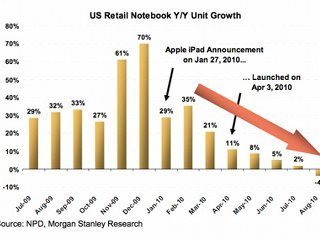

The debut of the iPad earlier this year threatened to throw a wrench into the gears of e-readers like Amazon’s Kindle, but some surprising trends have emerged over the last few months. Most notably, studies have revealed that the tablet owner and the e-reader owner are two very different people. But is that trend going to stick?
To get a better idea of what we can expect from the tablet/e-reader race in the next year, let’s recap. The Kindle was first introduced to the world in November 2007. It was a clunky piece of hardware with 250 MB of internal memory, making it capable of holding 200 books. The price: a tidy $399. But the people wanted it—desperately. The first generation Kindle sold out within five hours and remained out of stock until April 2008.
The first generation Kindle was followed by the much improved and lighter Kindle 2 in February 2009. With 2 GB of memory, the Kindle 2 was capable of holding 1,500 books. Finally, in July 2010, the Kindle 3 debuted with Wi-Fi and 3G capabilities, 4 GB of memory capable of holding 3,000 books, and a battery life of one month (with the Wi-Fi turned off). The price also dropped from $399 to $139 for the Wi-Fi only Kindle. The third generation proved to be Amazon’s top seller—rumored to have sold eight million units in 2010 compared to two million in 2009. The company recently announced that the Kindle 3 is its highest selling item of all time.
While fewer people own the iPad, it, too, has seen rapid growth since going on sale in April. Apple sold three million iPads in 80 days (which is one million more units than the Kindle is rumored to have sold in 2009) and more than 14 million units for 2010.
But research has shown that not only do more people own e-readers than tablets, but that they make up an entirely different demographic altogether. Women and non-whites are more likely to own an e-reader and purchase e-books while men and white respondents are more likely to own tablets. Additionally, while households with incomes over $75,000 are significantly more likely than others to own e-readers or tablets, households with incomes under $30,000 are more likely to own e-readers than tablets.
The price-tag appears to be the sticking point. The iPad is a hefty $499, more than times that of the Kindle. The Kindle saw a massive spike in sales when it slashed its $399 price-tag to $139, which explains why more lower-income households have e-readers than tablets.
My unsolicited forecast for 2011 is that once the iPad 2 becomes available, the price will drop as was the case for the iPhone. Apple is rumored to be shoring up the last remaining original iPads to sell while awaiting the debut of the iPad 2, and the price-tag on the original units will no doubt be significantly reduced, which will send sales through the roof—as we saw with the iPhone 3GS when the iPhone 4 arrived on the market.
However Apple plans to cut the price, once it does, consumers will have no reason to prefer the Kindle over the iPad. With the iPad’s e-reader capability and myriad other functions, the Kindle will be rendered obsolete—that is, unless it, too, drops its price, which it likely will. Amazon will be forced to go lower and lower, and it’s my belief that within the next year or so, the price of the Kindle will drop below $100 to keep up with ever-increasing iPad sales. Apple is rumored to be anticipating iPad sales to reach 40 million units in 2011.




















